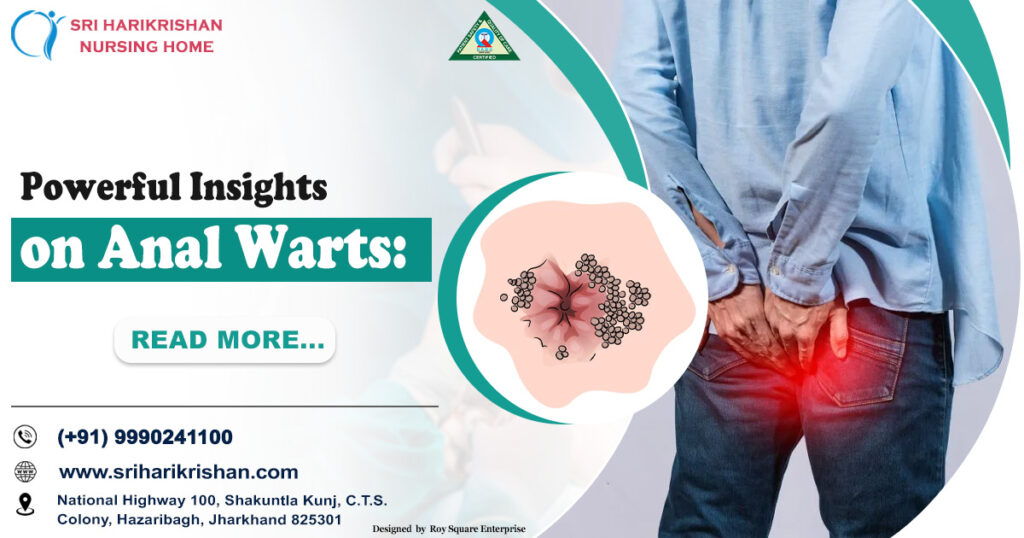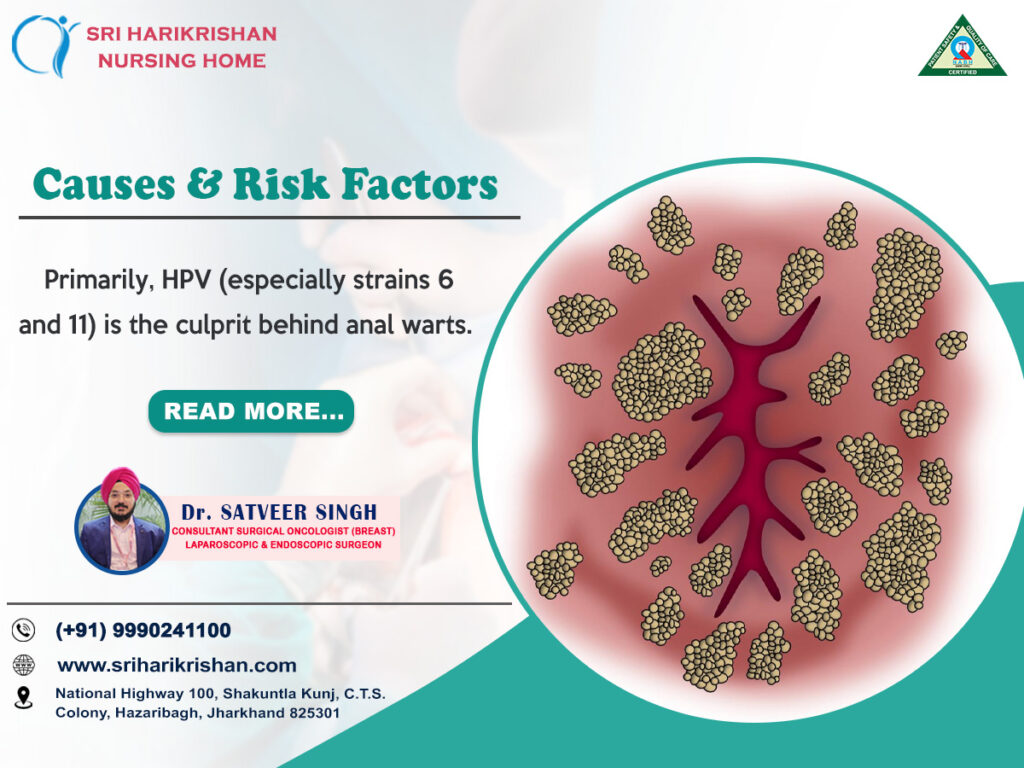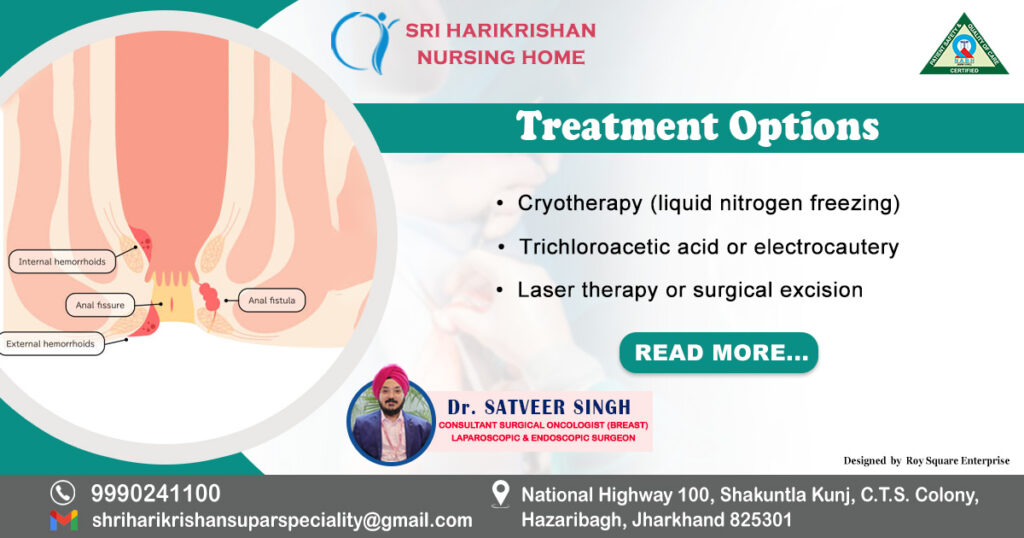
Introduction
Anal warts —though often overlooked—are an important health concern that demand accurate information and timely care. In this comprehensive guide, Dr. Satveer Singh, Consultant Surgical Oncologist (Breast) & Laparoscopic & Endoscopic Surgeon at Sri Harikrishan Nursing Home, offers expert insights across all faces of anal warts—from understanding their origins to managing recovery and beyond.
1. What Are Anal Warts?
Anal warts, medically known as condyloma acuminata, are growths in or around the anus caused by the human papillomavirus (HPV). These can appear as small, soft, dome-shaped bumps—often light brown, pink, yellow, or flesh-coloured—and may cluster into cauliflower-like shapes over time.
2. Symptoms to Watch For
Anal warts can be silent, but when present, symptoms may include:
1. Visible Growths Around the Anus
The most recognizable symptom of anal warts is the appearance of small, flesh-coloured or slightly brownish lumps around the anal area. These may:
- Start as tiny, soft bumps
- Be flat, raised, or cauliflower-shaped
- Appear singly or as clusters that grow and merge over time
- Range in colour from pink, brown, to off-white
These warts are often painless, which is why many people do not realize they have them until they become more prominent or irritating.
2. Sensation of a Lump or Fullness
Even without obvious visible signs, patients may feel a lump or experience a sensation of fullness around the anus. This may be more noticeable when sitting or during bowel movements.
This symptom is especially common when internal anal warts develop—those that grow inside the anal canal, making them invisible without medical examination.
3. Itching or Irritation
Anal warts frequently cause:
- Persistent itching or tingling
- A burning sensation, especially after bowel movements
- A general feeling of irritation or discomfort in the anal area
These symptoms can be mistaken for other conditions like haemorrhoids, anal fissures, or even yeast infections, making professional diagnosis essential.
4. Mucus Discharge
As warts grow and begin to irritate the skin and mucosa, they may lead to clear or yellowish mucus discharge. This discharge can:
- Soil undergarments
- Cause a moist feeling in the anal region
- Sometimes have an unpleasant Odor
- Chronic discharge may also lead to secondary skin infections or increased irritation.
5. Bleeding
Occasionally, anal warts may:
- Bleed slightly, especially during or after wiping
- Cause blood-streaked stools if internal warts are present
- Lead to micro-tears in the anal skin due to friction or scratching
While bleeding is usually minimal, it should never be ignored, as it may also be a sign of other more serious conditions like anal fissures or malignancy.
6. Discomfort During Bowel Movements
Anal warts—especially when internal or large—may cause:
- Pain or pressure during defecation
- A feeling of incomplete evacuation
- Increased sensitivity or stinging when wiping
These symptoms are often reported in cases where the warts are located inside the anal canal or when external warts have grown significantly in size.
7. Emotional and Psychological Impact
Although not a physical symptom, anal warts can have a profound emotional and psychological toll due to:
- Embarrassment or shame
- Anxiety about sexual relationships
- Fear of recurrence or transmission to a partner
- Stress from the stigma associated with sexually transmitted infections (STIs)
This highlights the importance of compassionate, confidential, and professional care, such as that provided by Dr. Satveer Singh, Consultant Surgical Oncologist (Breast), Laparoscopic & Endoscopic Surgeon at Sri Harikrishan Nursing Home. Dr. Singh’s patient-centred approach ensures individuals receive not only the right medical treatment but also the emotional reassurance they need.

3. Causes & Risk Factors
Primarily, HPV (especially strains 6 and 11) is the culprit behind anal warts. It’s spread via skin-to-skin or sexual contact, not necessarily intercourse. Risk increases with:
1. Human Papillomavirus (HPV) – The Primary Cause
HPV is a DNA virus that infects the skin and mucous membranes. It spreads through skin-to-skin contact, not just sexual intercourse. Once HPV enters the body, it alters the normal skin cell behaviour, causing the infected tissue to grow rapidly—resulting in the formation of warts.
Key facts about HPV and anal warts:
- HPV types 6 and 11 cause most anal warts.
- Infection can remain dormant for weeks, months, or even years before symptoms appear.
- You can carry and transmit HPV even if you don’t have visible warts.
- Immunosuppression increases the chance that a latent HPV infection will become symptomatic.
2. Modes of Transmission
HPV—and therefore anal warts—can be transmitted in several ways:
A. Sexual Contact
- Anal intercourse (receptive or incentive)
- Genital-to-anal contact
- Oral-to-anal contact (rare, but possible)
- Sexual touching or sharing sex toys
Even skin contact in the genital area, without penetration, can spread HPV.
B. Autoinoculation (Self-Transmission)
People with genital warts may spread the virus to the anal area through:
- Wiping
- Scratching
- Poor hygiene
- Shaving over warts
C. Non-Sexual Transmission
While rare, HPV can also be spread:
- From mother to baby during childbirth (if warts are present)
- Through shared personal hygiene tools (like razors or towels) under unhygienic conditions
3. Risk Factors That Increase the Likelihood of Developing Anal Warts
Certain conditions and behaviours can increase your susceptibility to HPV infection and the development of anal warts:
A. Multiple Sexual Partners
The more partners you have, the higher the risk of HPV exposure—especially if unprotected sex is involved.
B. Receptive Anal Sex
Those who engage in receptive anal intercourse are at greater risk due to the fragility of anal mucosa, which makes viral entry easier.
C. Weakened Immune System
Individuals with compromised immunity, such as:
- HIV-positive individuals
- Organ transplant recipients
- People on long-term immunosuppressants
…are more prone to persistent and recurring warts.
D. Smoking
Smoking weakens the immune system and is believed to facilitate HPV persistence and lesion growth.
E. Poor Hygiene
Lack of proper genital and anal hygiene can create a favourable environment for HPV infection to spread.
F. Existing Genital Warts
If you already have genital warts, you are at higher risk of spreading the virus to the anal region—even without direct anal contact.
4. Vertical Transmission (Mother to Baby)
In rare cases, HPV can be passed from a pregnant mother to her baby during vaginal delivery. This can cause:
- Anal or genital warts in infants
- Rarely, respiratory papillomatosis, where warts form in the baby’s throat
Doctors like Dr. Satveer Singh, Consultant Surgical Oncologist (Breast), Laparoscopic & Endoscopic Surgeon at Shri Harikrishan Nursing Home, emphasize the importance of prenatal screening and treatment of warts to prevent complications during childbirth.
5. Latency and Reactivation of HPV
One of the more confusing aspects of anal warts is their unpredictable onset.
- HPV can remain dormant in the body for months or even years.
- Even if someone hasn’t had sexual contact recently, old infections can reactivate when the immune system is weakened.
- This means people may develop anal warts without recent exposure, which can lead to confusion and stigma.
4. Diagnosis
Effective diagnosis includes:
- Visual inspection by a physician, often sufficient to identify warts
- Anoscopy, to detect internal lesions using a small lighted scope
- Biopsy, reserved for atypical, non-responsive, or suspicious lesions

5. Treatment Options
Physical & Surgical Methods (for larger or internal warts):
- Cryotherapy (liquid nitrogen freezing)
- Trichloroacetic acid or electrocautery
- Laser therapy or surgical excision, especially for extensive/internal lesions
Treatment may require multiple sessions and a tailored approach depending on location, size, and symptoms.
6. Recovery & Outlook
Recovery varies by treatment:
- Minor treatments like topical agents often cause mild irritation.
- Cryotherapy and cautery may lead to discomfort for several days.
- Surgical removal may require a week or two for healing.
- Recurrence is common, as HPV persists in the body—even after visible warts are removed, follow-up is essential.
Real patient experiences illustrate this: one noted healing around 4–6 weeks; another found recovery slower but reassuring over time. Others shared the emotional challenge of recurrences, but also progress in management strategies.
7. Top 10 Myths vs. Facts About Anal Warts
| Myth | Fact |
| 1. Anal warts always cause pain. | Many people have no pain or noticeable symptoms. |
| 2. You must have anal sex to get them. | HPV spreads through skin-to-skin contact, not just anal intercourse. |
| 3. Warts always go away without treatment. | Some may disappear, but medical evaluation is recommended. |
| 4. Over-the-counter wart remover’s work. | OTC wart treatments are not safe for sensitive anal tissue. |
| 5. One treatment is enough. | Multiple treatments are often needed, especially for recurrences. |
| 6. Anal warts always lead to cancer. | Only certain HPV strains cause cancer, but treatment helps reduce risks. |
| 7. HPV can be cured with surgery. | Surgery removes warts, not the underlying virus—recurrence is possible. |
| 8. Warts can’t recur after treatment. | HPV remains in the body—follow-up is key. |
| 9. All treatments are painful. | Some options are minimally invasive with mild discomfort. |
| 10. Warts only affect the anus. | They can also appear on genital skin or other areas in contact. |
8. Top 10 FAQs on Anal Warts
- Do anal warts always cause symptoms?
No—they can be painless and unnoticed, especially when internal. - Are anal warts serious?
While often benign, some HPV types can increase cancer risk—early detection is proactive care. - Can over-the-counter treatments help?
No—OTC wart removers aren’t safe for anal areas; use only physician-recommended treatments. - Does treatment eliminate HPV?
No—treatment removes warts, but HPV may remain dormant, requiring vigilance. - Is surgery painful?
Most patients experience manageable discomfort; procedures are often outpatient with recovery in 1–2 weeks. - Can warts return after treatment?
Yes—recurrence is common, especially if HPV persists. - How often should I follow up post-treatment?
Regular follow-up—especially in the first few months—is critical to monitor for recurrences. - Is prevention possible?
HPV vaccination, condom use, limiting partners, and regular screening can reduce risk—though condoms aren’t 100% protective. - Can weakened immunity affect recurrence?
Yes, immunocompromised individuals may face higher recurrence and require careful monitoring. - Can internal warts be treated non-surgically?
Internal lesions often require surgical methods such as excision or laser to ensure full removal.
Final Words & Professional Guidance
Anal warts can be distressing—physically and emotionally—but with informed, compassionate guidance, effective treatment and recovery are within reach. Dr. Satveer Singh, a seasoned surgical oncologist skilled in both minimally invasive and advanced techniques, is dedicated to offering personalized, informed care at Shri Harikrishan Nursing Home.
Through expert diagnosis, tailored treatment plans, and supportive follow-ups, Dr. Singh ensures you receive both medical precision and compassionate support on your journey to recovery.
Stay proactive, stay informed, and know that you’re not alone—help and healing are available.
